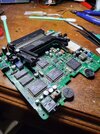Hello all. I'm currently trying to repair a damaged PC engine LT (a portable games console circa 1991)I got a few years ago. The thing had 10+ lifted pads and three lifted traces from corrosion from bad caps when I got it, and the first step was to clean it and repair the traces and pads as best I could using some copper and a high temperature two part epoxy, then replace the capacitors. Of course it would be amazing if that had fixed the console, but things are never so simple. I've double checked the capacitors, and I'm (90%) confident that they have connectivity where they need to have connectivity, but we still have no video out and no sound. I've checked the voltage and ground to the CPU and graphics chips, and both are correct. I've also checked the connectivity from the chip to the external bus, which, while not linked to the screen, is nearby and traverses the motherboard from the chip. There's also a fairly good 1-1 correspondence from the GPU pins to the pinout of the bus.
The next thing I attempted to measure was the oscillator, and here, I'm not seeing what I'm expecting. I see a wave, though it's not perfectly square (straight up or down, then a slope immediately back to 0v, flat line, repeat), but the issue is the frequency is not what I was expecting. I'd expect to see the pattern at 50ns, but instead I'm seeing it at 5ms. The oscillator should provide a 3.579545 MHz clock signal (NTSC video).
I'm a complete newbie having never used an oscilloscope before, so it may be that I'm doing something wrong, but the signal is well defined at that range, so it looks like there's an issue. How would I go about diagnosing the issue from here?
The next thing I attempted to measure was the oscillator, and here, I'm not seeing what I'm expecting. I see a wave, though it's not perfectly square (straight up or down, then a slope immediately back to 0v, flat line, repeat), but the issue is the frequency is not what I was expecting. I'd expect to see the pattern at 50ns, but instead I'm seeing it at 5ms. The oscillator should provide a 3.579545 MHz clock signal (NTSC video).
I'm a complete newbie having never used an oscilloscope before, so it may be that I'm doing something wrong, but the signal is well defined at that range, so it looks like there's an issue. How would I go about diagnosing the issue from here?

